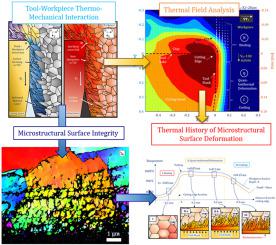International Journal of Machine Tools and Manufacture ( IF 14.0 ) Pub Date : 2021-06-19 , DOI: 10.1016/j.ijmachtools.2021.103765 Andrea la Monaca , Dragos A. Axinte , Zhirong Liao , Rachid M'Saoubi , Mark C. Hardy

|
Despite the ongoing progress in metallurgical characterisation of machined surfaces, knowledge of the thermal conditions under which they originate during the workpiece-flank interaction is still lacking. When cutting advanced superalloys, little is known about temperature evolution in the machined part volume, where workpiece material interacts with the tool flank. In this work, the characteristics of the thermal field and the resulting surface metallurgy induced in a next generation nickel-base superalloy have been studied for cutting scenarios involving different combinations of thermo-mechanical boundary conditions. Analysis of the thermal field evolution in the workpiece subsurface has allowed the heating and cooling rates induced by cutting to be revealed, allowing description of two distinct types of thermal cycle, with a Heating-Peaking-Cooling (H–P–C) and a Heating-Quasi-isothermal Deformation-Cooling (HQC) structure depending on the process aggressiveness. Subsurface thermal history has been found to relate with the severity of the cutting-induced deformation, as it combines information on thermal field magnitude and on the process rates. Furthermore, thermal balance equations have been applied to study the rate of the heat generation in the machined subsurface due to its own plastic deformation while interacting with the tool flank. This has revealed that the highest rate of heat generation induced by plastic deformation occurred in thin surface layers at the beginning of the workpiece-flank contact, which has been associated to the conditions under which white layers (WLs) are generated. Energy balance analysis has furthermore indicated the development of a less severe and less impulsive deformation process at higher subsurface depths, which has been linked to the formation mechanism of material drag (MD) layers. In this way, the thermal history of machined surfaces has been related to their resulting metallurgical integrity, allowing in-depth understanding of the physical conditions developing when cutting next-generation superalloys.
中文翻译:

了解切割下一代粉末冶金镍基高温合金时微观结构表面变形的热历史
尽管在加工表面的冶金表征方面不断取得进展,但仍然缺乏对它们在工件-侧面相互作用期间产生的热条件的了解。在切削高级高温合金时,对加工零件体积中的温度变化知之甚少,其中工件材料与刀具侧面相互作用。在这项工作中,研究了下一代镍基高温合金中的热场特性和由此产生的表面冶金,用于涉及不同热机械边界条件组合的切割场景。对工件表面下热场演化的分析可以揭示切割引起的加热和冷却速率,从而可以描述两种不同类型的热循环,具有加热-峰值-冷却 (H-P-C) 和加热-准等温变形-冷却 (HQC) 结构,具体取决于工艺侵蚀性。已发现地下热历史与切割引起的变形的严重程度有关,因为它结合了热场大小和加工速率的信息。此外,热平衡方程已被应用于研究加工表面下由于其自身的塑性变形而与刀具侧面相互作用而产生的热量。这表明,由塑性变形引起的最高发热率发生在工件与侧面接触开始时的薄表面层中,这与产生白层 (WL) 的条件有关。此外,能量平衡分析还表明,在较高的地下深度处,发生了较不严重和较少脉冲的变形过程,这与材料阻力 (MD) 层的形成机制有关。通过这种方式,加工表面的热历史与其产生的冶金完整性有关,从而可以深入了解切割下一代高温合金时的物理条件。



























 京公网安备 11010802027423号
京公网安备 11010802027423号